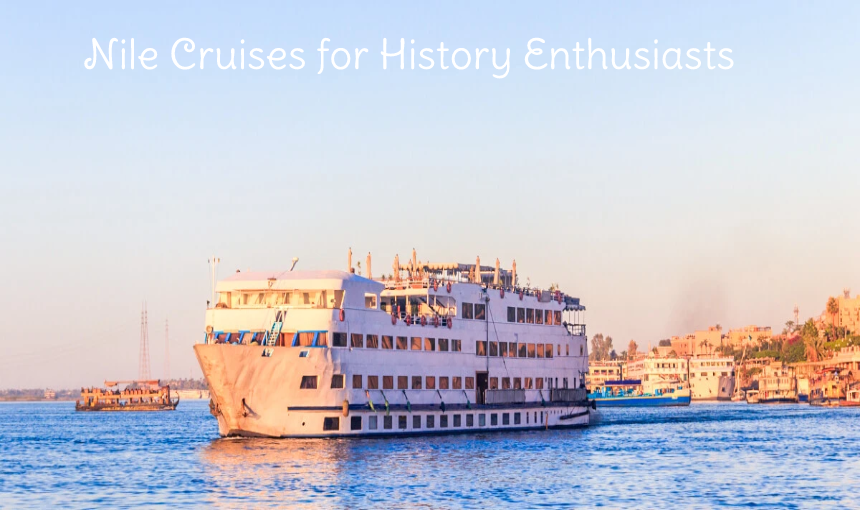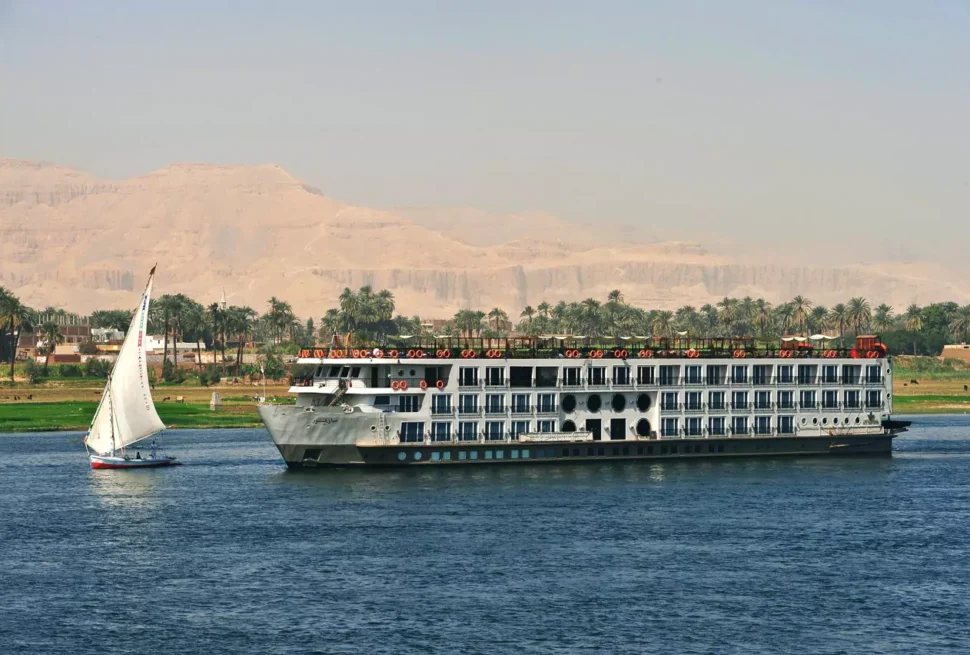Introduction:
The Nile River has been the lifeblood of Egypt for millennia, shaping its history and culture in profound ways. Nile Cruises for history enthusiasts, a Nile cruise offers an unparalleled opportunity to explore the ancient civilizations that flourished along its banks. From the grandeur of the pyramids to the majestic temples of Luxor and Karnak, a Nile cruise is a journey through time. Providing a deep dive into the wonders of ancient Egypt. This guide highlights the key historical sites along the Nile and offers tips for making the most of your journey. Tailored for those passionate about history.
Nile Cruises for History Enthusiasts: A Journey Through Time
Why Choose a Nile Cruise for Historical Exploration?
- Access to Iconic Historical Sites: A Nile cruise allows you to visit some of the most significant archaeological sites in the world. Including the Valley of the Kings, the Temple of Hatshepsut, and the temples of Edfu and Kom Ombo.
- Expert-Led Tours: Many Nile cruises offer guided tours led by Egyptologists, providing in-depth knowledge and insights into the historical significance of the sites you visit.
- Comfort and Convenience: Traveling by cruise offers a comfortable and luxurious way to explore Egypt’s ancient wonders. With accommodation, dining, and transportation all in one package.
- A Unique Perspective: Viewing Egypt’s historical sites from the Nile offers a unique perspective. As many of these landmarks were originally built to be seen from the river.
Top Historical Sites to Visit on a Nile Cruise
1. The Pyramids of Giza
- Location: Giza, just outside Cairo.
- Historical Significance: The Pyramids of Giza are the last remaining wonder of the ancient world. Built as tombs for the pharaohs Khufu, Khafre, and Menkaure.
- Key Features:
- Great Pyramid of Khufu: The largest of the three pyramids and a marvel of ancient engineering.
- Sphinx: A colossal limestone statue with the body of a lion and the head of a pharaoh, guarding the Giza plateau.
- Solar Boat Museum: Houses the reconstructed solar boat of Khufu. Believed to have been used in his journey to the afterlife.
- Why Visit: No visit to Egypt is complete without seeing the pyramids, a testament to the ingenuity and power of the ancient Egyptians.
2. The Temples of Luxor and Karnak
- Location: Luxor, on the east bank of the Nile.
- Historical Significance: Luxor and Karnak are among the most significant religious complexes in ancient Egypt. Dedicated to the god Amun and other deities.
- Key Features:
- Luxor Temple: A magnificent temple complex featuring massive columns, statues, and the Avenue of Sphinxes.
- Karnak Temple: The largest religious building ever constructed, with the impressive Hypostyle Hall, obelisks, and sacred lake.
- Luxor Museum: Displays a collection of artifacts from the Theban area, including statues, jewelry, and mummies.
- Why Visit: These temples offer a deep insight into the religious and political life of ancient Egypt. Showcasing stunning architecture and art.
3. Valley of the Kings
- Location: Luxor, on the west bank of the Nile.
- Historical Significance: The Valley of the Kings served as the burial site for pharaohs of the New Kingdom. Including Tutankhamun, Seti I, and Ramesses II.
- Key Features:
- Tomb of Tutankhamun: The most famous tomb, discovered by Howard Carter in 1922, containing the pharaoh’s intact burial treasures.
- Tomb of Seti I: One of the longest and most elaborately decorated tombs in the valley.
- Deir el-Bahari: The mortuary temple complex of Hatshepsut, known for its unique architectural design.
- Why Visit: The Valley of the Kings offers a glimpse into the afterlife beliefs of the ancient Egyptians. With tombs adorned with intricate artwork and hieroglyphs.
4. Temple of Hatshepsut
- Location: Luxor, on the west bank of the Nile.
- Historical Significance: The Temple of Hatshepsut is one of the most striking and well-preserved temples in Egypt. Dedicated to the female pharaoh Hatshepsut.
- Key Features:
- Terraced Design: The temple is built into the cliffs of Deir el-Bahari, with a series of terraces connected by ramps.
- Statues and Reliefs: The temple is adorned with statues of Hatshepsut and detailed reliefs depicting her divine birth and trading expeditions to Punt.
- Sanctuary of Amun: A small but significant chamber at the top of the temple, dedicated to the god Amun.
- Why Visit: The Temple of Hatshepsut is a testament to the architectural innovation of the New Kingdom and the power of one of Egypt’s most successful female rulers.
5. Edfu and Kom Ombo Temples
- Location: Edfu and Kom Ombo, on the west bank of the Nile.
- Historical Significance: These temples are dedicated to important deities in the ancient Egyptian pantheon, with Edfu dedicated to Horus and Kom Ombo to both Sobek and Horus.
- Key Features:
- Temple of Horus at Edfu: One of the best-preserved temples in Egypt, featuring a large pylon, inner sanctuary, and detailed reliefs depicting the battle between Horus and Set.
- Temple of Kom Ombo: Unique for its double dedication, with twin sanctuaries for Sobek and Horus, and a nearby Crocodile Museum.
- Nilometers: Ancient devices used to measure the level of the Nile, crucial for agriculture and flood predictions.
- Why Visit: These temples provide a closer look at the religious practices of ancient Egypt, with well-preserved structures and unique design features.
Check the Best Nile Cruises for History Enthusiasts:
- Standard 5 Stars Nile Cruise.
- Deluxe 5 Stars Nile Cruise.
- Luxury 5 Stars Nile Cruise.
- Ultra Luxury 5 Stars Nile Cruise.
- Lake Nasser Nile Cruise.
- Dahabyia Nile Cruise.
- Felucca Adventure Nile Cruise.
- Cairo Dinner Cruise.
Tips for History Enthusiasts on a Nile Cruise
- Choose a Cruise with Egyptologist Guides: Look for cruises that offer guided tours by professional Egyptologists to gain deeper insights into the historical sites you visit.
- Plan for Extra Time at Key Sites: Allocate additional time at major historical sites like the Valley of the Kings or Karnak Temple to fully appreciate their significance.
- Read Up on Egyptian History Before Your Trip: Familiarize yourself with the history of ancient Egypt to enhance your understanding and enjoyment of the sites you’ll visit.
- Consider a Themed Cruise: Some Nile cruises are specifically tailored for history enthusiasts, focusing on in-depth exploration of Egypt’s historical landmarks.
A Nile cruise offers history enthusiasts an extraordinary journey through one of the world’s most ancient and fascinating civilizations. From the awe-inspiring pyramids to the majestic temples of Luxor, each site along the Nile tells a story of Egypt’s rich cultural heritage. Whether you’re a seasoned historian or simply passionate about the past. A Nile cruise provides the perfect blend of education and adventure.
Ready to embark on a historical journey along the Nile? Explore our selection of Nile cruises designed for history enthusiasts and book your trip today. Dive into the wonders of ancient Egypt and create memories that will last a lifetime!
Follow us on Facebook, Instagram, Pinterest and X to find more about Nile Cruises for History Enthusiasts.
Don't miss checking our other Egypt Nile Cruises




